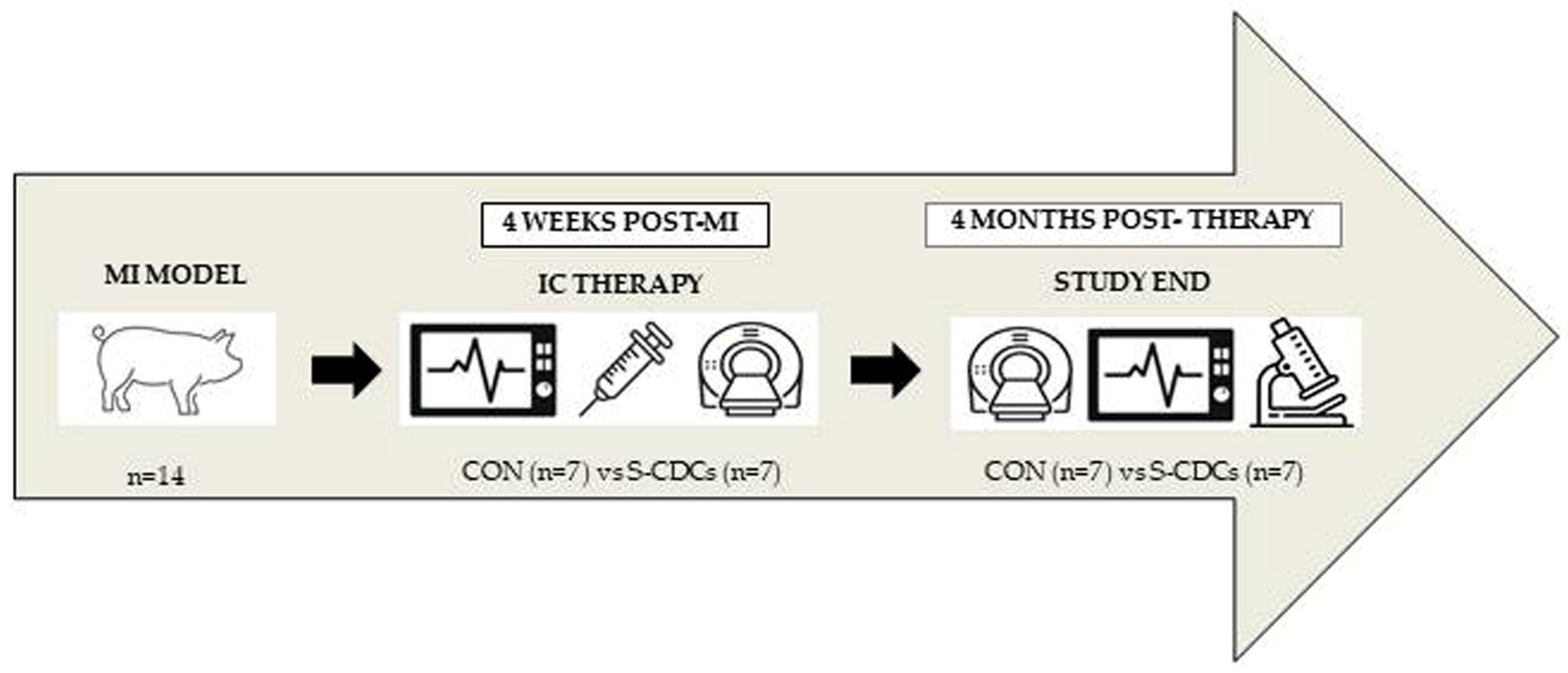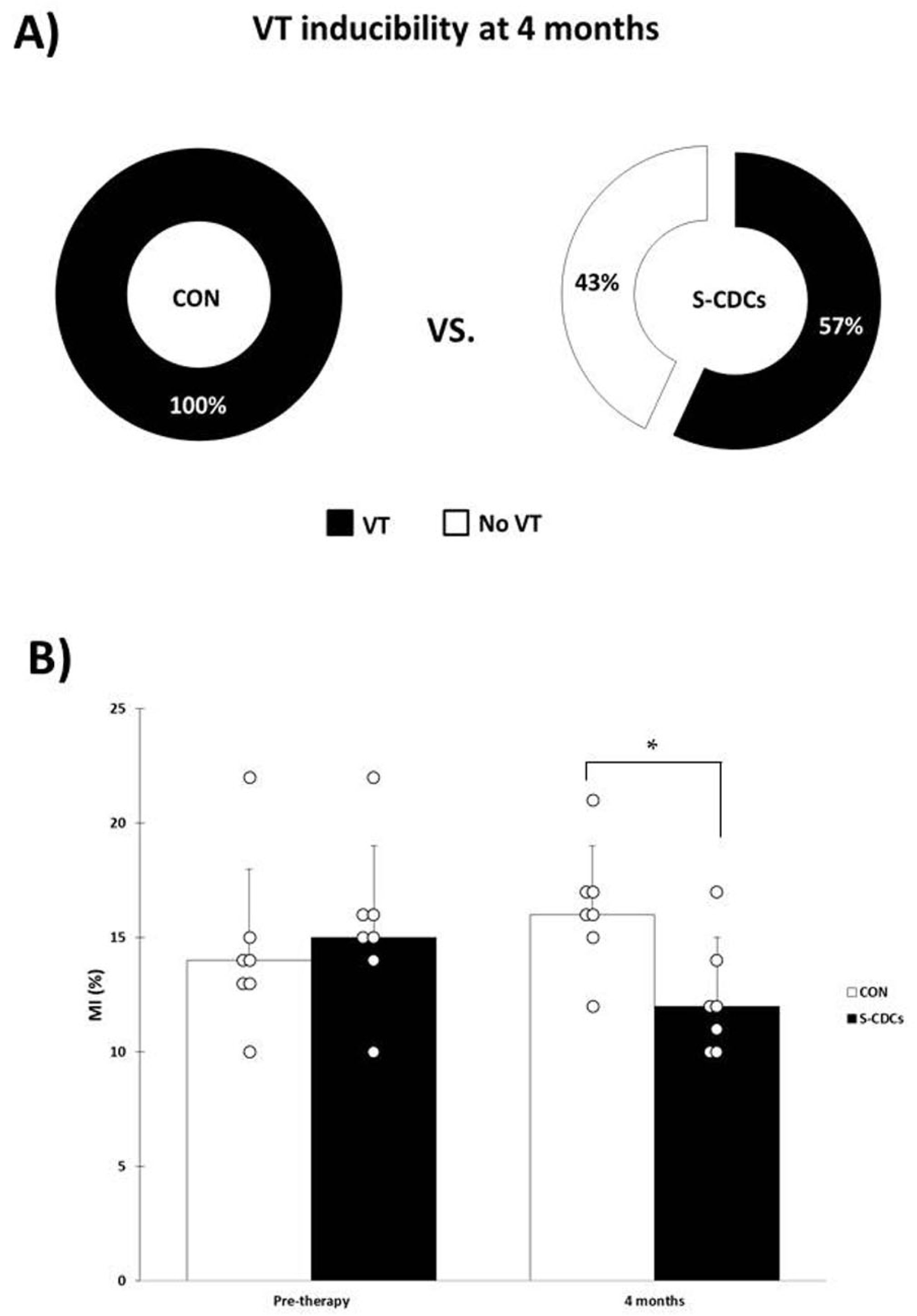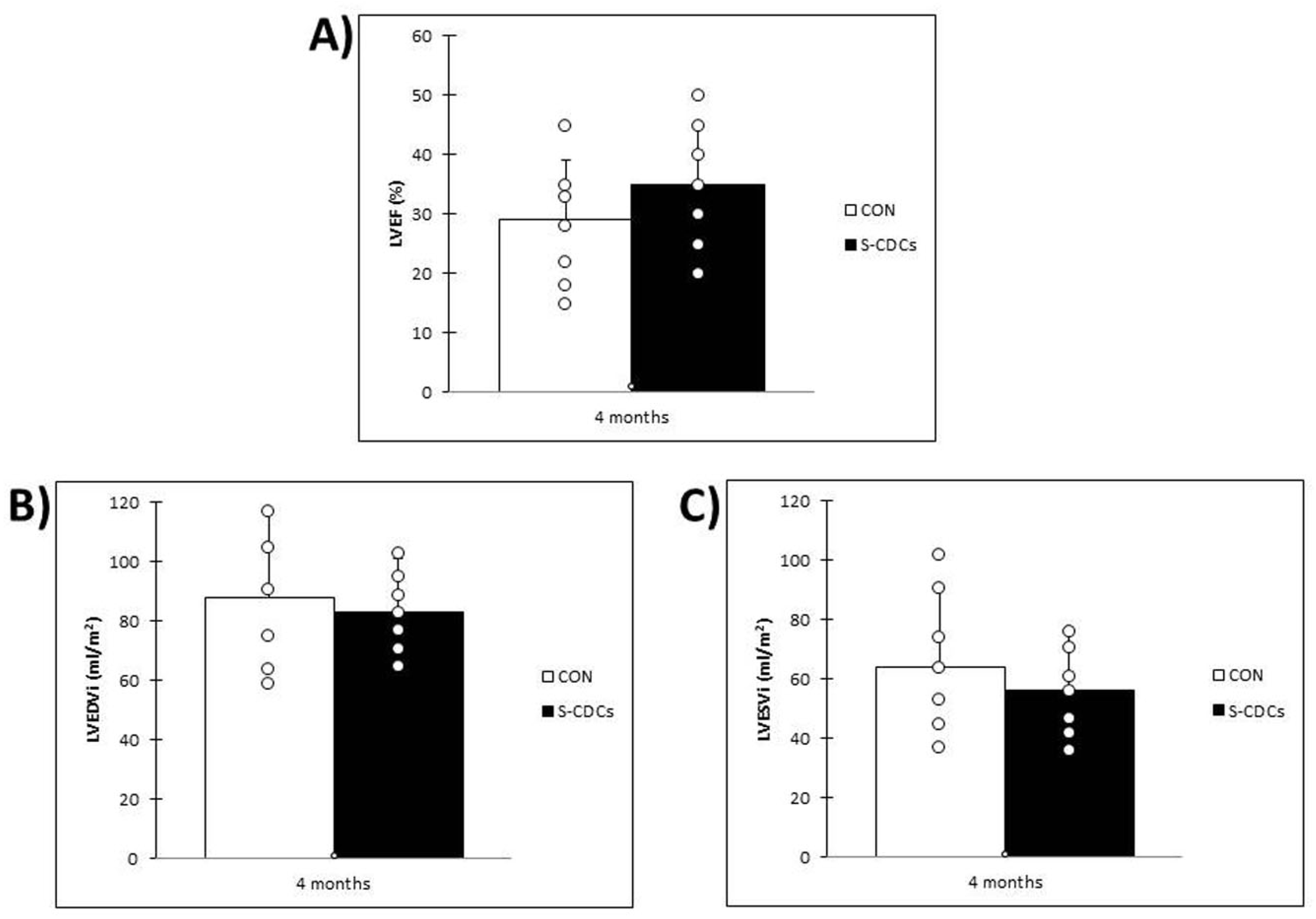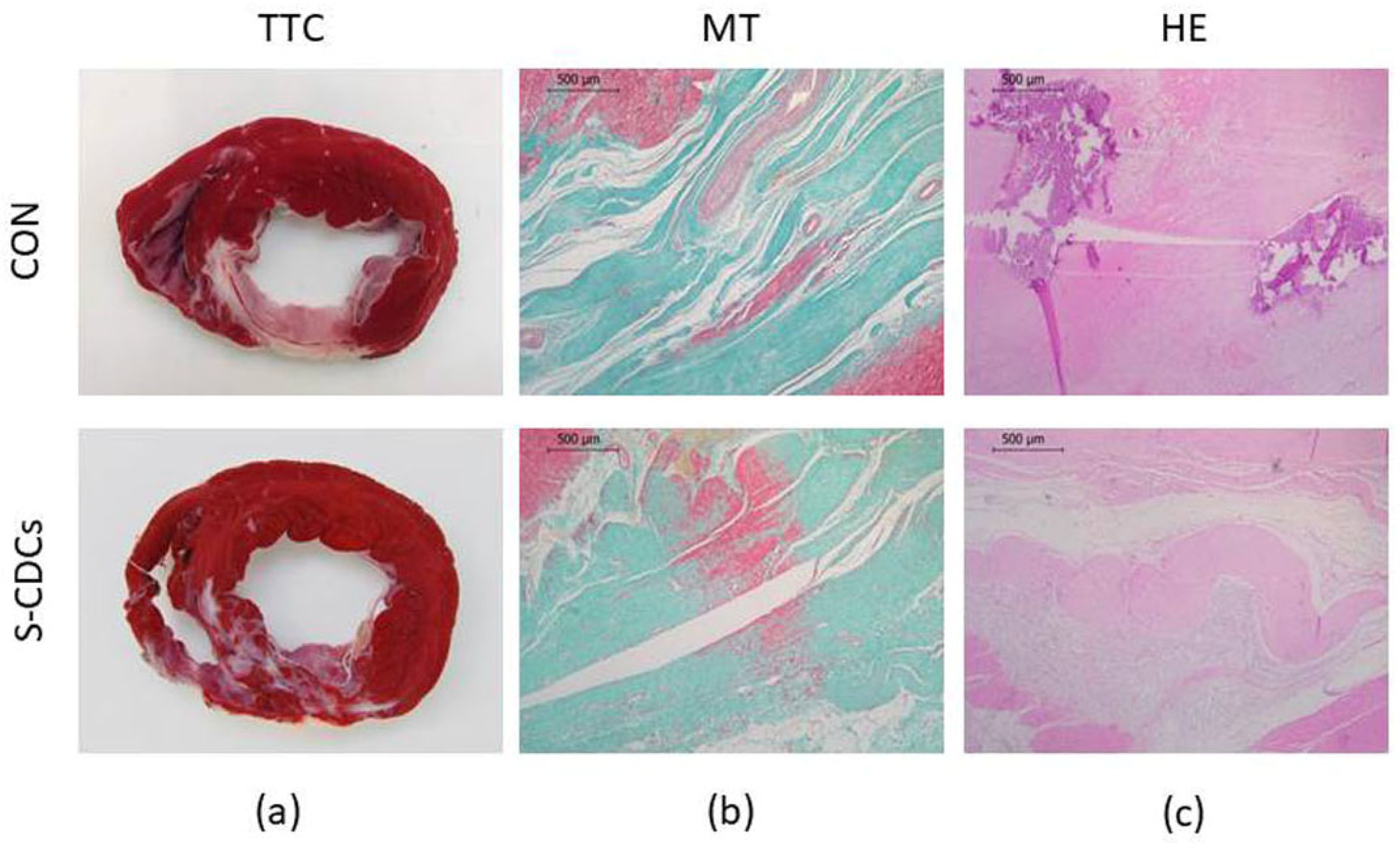Intracoronary-Cardiosphere-Derived Cell Secretome Therapy: Effects on Ventricular Tachycardia Inducibility and Cardiac Function in a Swine Model
Abstract
:1. Introduction
2. Materials and Methods
2.1. Anaesthesia and Analgesia
2.2. Infarct Induction
2.3. Isolation of S-CDCs
2.4. IC Administration
2.5. MRI Studies
2.6. Programmed Electrical Stimulation (PES)
2.7. End Study
2.8. Statistical Analysis
3. Results
4. Discussion
4.1. Limitations
4.2. Future Directions
5. Conclusions
Supplementary Materials
Author Contributions
Funding
Institutional Review Board Statement
Informed Consent Statement
Data Availability Statement
Acknowledgments
Conflicts of Interest
References
- Dawkins, J.F.; Ehdaie, A.; Rogers, R.; Soetkamp, D.; Valle, J.; Holm, K.; Sanchez, L.; Tremmel, I.; Nawaz, A.; Shehata, M.; et al. Biological substrate modification suppresses ventricular arrhythmias in a porcine model of chronic ischaemic cardiomyopathy. Eur. Heart J. 2022, 43, 2139–2156. [Google Scholar] [CrossRef] [PubMed]
- Curtain, J.P.; Pfeffer, M.A.; Braunwald, E.; Claggett, B.L.; Granger, C.B.; Køber, L.; Lewis, E.F.; Maggioni, A.P.; Mann, D.L.; Rouleau, J.L.; et al. Rates of Sudden Death After Myocardial Infarction—Insights From the VALIANT and PARADISE-MI Trials. JAMA Cardiol. 2024, 9, 928–933. [Google Scholar] [CrossRef] [PubMed]
- Zaman, S.; Kovoor, P. Sudden cardiac death early after myocardial infarction: Pathogenesis, risk stratification, and primary prevention. Circulation 2014, 129, 2426–2435. [Google Scholar] [CrossRef] [PubMed]
- Al-Khatib, S.M.; Stevenson, W.G.; Ackerman, M.J.; Bryant, W.J.; Callans, D.J.; Curtis, A.B.; Deal, B.J.; Dickfeld, T.; Field, M.E.; Fonarow, G.C.; et al. 2017 AHA/ACC/HRS Guideline for Management of Patients with Ventricular Arrhythmias and the Prevention of Sudden Cardiac Death: Executive Summary: A Report of the American College of Cardiology/American Heart Association Task Force on Clinical Practice Guidelines and the Heart Rhythm Society. Circulation 2018, 138, e210–e271, Erratum in: Circulation 2018, 138, e415–e418. https://doi.org/10.1161/CIR.0000000000000615. [Google Scholar] [CrossRef]
- Dukkipati, S.R.; Koruth, J.S.; Choudry, S.; Miller, M.A.; Whang, W.; Reddy, V.Y. Catheter Ablation of Ventricular Tachycardia in Structural Heart Disease: Indications, Strategies, and Outcomes-Part II. J. Am. Coll. Cardiol. 2017, 70, 2924–2941. [Google Scholar] [CrossRef]
- Arenal, Á.; Ríos-Muñoz, G.R.; Carta-Bergaz, A.; Ruiz-Hernández, P.M.; Pérez-David, E.; Crisóstomo, V.; Loughlin, G.; Sanz-Ruiz, R.; Fernández-Portales, J.; Acosta, A.; et al. Effects of Cardiac Stem Cell on Postinfarction Arrhythmogenic Substrate. Int. J. Mol. Sci. 2022, 23, 16211. [Google Scholar] [CrossRef]
- Johnston, P.V.; Sasano, T.; Mills, K.; Evers, R.; Lee, S.T.; Smith, R.R.; Lardo, A.C.; Lai, S.; Steenbergen, C.; Gerstenblith, G.; et al. Engraftment, differentiation, and functional benefits of autologous cardiosphere-derived cells in porcine ischemic cardiomyopathy. Circulation 2009, 120, 1075–1083. [Google Scholar] [CrossRef]
- Makkar, R.R.; Smith, R.R.; Cheng, K.; Malliaras, K.; Thomson, L.E.; Berman, D.; Czer, L.S.; Marbán, L.; Mendizabal, A.; Johnston, P.V.; et al. Intracoronary cardiosphere-derived cells for heart regeneration after myocardial infarction (CADUCEUS): A prospective, randomised phase 1 trial. Lancet 2012, 379, 895–904. [Google Scholar] [CrossRef]
- Malliaras, K.; Li, T.S.; Luthringer, D.; Terrovitis, J.; Cheng, K.; Chakravarty, T.; Galang, G.; Zhang, Y.; Schoenhoff, F.; Van Eyk, J.; et al. Safety and efficacy of allogeneic cell therapy in infarcted rats transplanted with mismatched cardiosphere-derived cells. Circulation 2012, 125, 100–112. [Google Scholar] [CrossRef]
- Malliaras, K.; Smith, R.R.; Kanazawa, H.; Yee, K.; Seinfeld, J.; Tseliou, E.; Dawkins, J.F.; Kreke, M.; Cheng, K.; Luthringer, D.; et al. Validation of contrast-enhanced magnetic resonance imaging to monitor regenerative efficacy after cell therapy in a porcine model of convalescent myocardial infarction. Circulation 2013, 128, 2764–2775. [Google Scholar] [CrossRef]
- Malliaras, K.; Makkar, R.R.; Smith, R.R.; Cheng, K.; Wu, E.; Bonow, R.O.; Marbán, L.; Mendizabal, A.; Cingolani, E.; Johnston, P.V.; et al. Intracoronary cardiosphere-derived cells after myocardial infarction: Evidence of therapeutic regeneration in the final 1-year results of the CADUCEUS trial (CArdiosphere-Derived aUtologous stem CElls to reverse ventricUlar dySfunction). J. Am. Coll. Cardiol. 2014, 63, 110–122. [Google Scholar] [CrossRef] [PubMed]
- Ibrahim, A.G.; Cheng, K.; Marbán, E. Exosomes as critical agents of cardiac regeneration triggered by cell therapy. Stem. Cell Rep. 2014, 2, 606–619. [Google Scholar] [CrossRef] [PubMed]
- Tseliou, E.; Fouad, J.; Reich, H.; Slipczuk, L.; de Couto, G.; Aminzadeh, M.; Middleton, R.; Valle, J.; Weixin, L.; Marbán, E. Fibroblasts Rendered Antifibrotic, Antiapoptotic, and Angiogenic by Priming with Cardiosphere-Derived Extracellular Membrane Vesicles. J. Am. Coll. Cardiol. 2015, 66, 599–611. [Google Scholar] [CrossRef] [PubMed]
- Kreke, M.; Smith, R.R.; Marbán, L.; Marbán, E. Cardiospheres and cardiosphere-derived cells as therapeutic agents following myocardial infarction. Expert Rev. Cardiovasc. Ther. 2012, 10, 1185–1194. [Google Scholar] [CrossRef]
- Gallet, R.; Dawkins, J.; Valle, J.; Simsolo, E.; de Couto, G.; Middleton, R.; Tseliou, E.; Luthringer, D.; Kreke, M.; Smith, R.R.; et al. Exosomes secreted by cardiosphere-derived cells reduce scarring, attenuate adverse remodelling, and improve function in acute and chronic porcine myocardial infarction. Eur. Heart J. 2017, 38, 201–211. [Google Scholar] [CrossRef]
- Crisostomo, V.; Baez, C.; Abad, J.L.; Sanchez, B.; Alvarez, V.; Rosado, R.; Gómez-Mauricio, G.; Gheysens, O.; Blanco-Blazquez, V.; Blazquez, R.; et al. Dose-dependent improvement of cardiac function in a swine model of acute myocardial infarction after intracoronary administration of allogeneic heart-derived cells. Stem Cell Res Ther. 2019, 10, 152. [Google Scholar] [CrossRef]
- Blázquez, R.; Sánchez-Margallo, F.M.; Crisóstomo, V.; Báez, C.; Maestre, J.; Álvarez, V.; Casado, J.G. Intrapericardial Delivery of Cardiosphere-Derived Cells: An Immunological Study in a Clinically Relevant Large Animal Model. PLoS ONE 2016, 11, e0149001. [Google Scholar] [CrossRef]
- López, E.; Marinaro, F.; de Pedro, M.L.Á.; Sánchez-Margallo, F.M.; Gómez-Serrano, M.; Ponath, V.; Pogge von Strandmann, E.; Jorge, I.; Vázquez, J.; Fernández-Pereira, L.M.; et al. The Immunomodulatory Signature of Extracellular Vesicles From Cardiosphere-Derived Cells: A Proteomic and miRNA Profiling. Front. Cell. Dev. Biol. 2020, 8, 321. [Google Scholar] [CrossRef]
- Crisóstomo, V.; Baéz-Diaz, C.; Blanco-Blázquez, V.; Álvarez, V.; López-Nieto, E.; Maestre, J.; Bayes-Genis, A.; Gálvez-Montón, C.; Casado, J.G.; Sánchez-Margallo, F.M. The epicardial delivery of cardiosphere derived cells or their extracellular vesicles is safe but of limited value in experimental infarction. Sci. Rep. 2021, 11, 22155. [Google Scholar] [CrossRef]
- Báez-Díaz, C.; Blanco-Blázquez, V.; Sánchez-Margallo, F.M.; Bayes-Genis, A.; González, I.; Abad, A.; Steendam, R.; Franssen, O.; Palacios, I.; Sánchez, B.; et al. Microencapsulated Insulin-Like Growth Factor-1 therapy improves cardiac function and reduces fibrosis in a porcine acute myocardial infarction model. Sci. Rep. 2020, 10, 7166. [Google Scholar] [CrossRef]
- Sasano, T.; Kelemen, K.; Greener, I.D.; Donahue, J.K. Ventricular tachycardia from the healed myocardial infarction scar: Validation of an animal model and utility of gene therapy. Heart Rhythm 2009, 6 (Suppl. S8), S91–S97. [Google Scholar] [CrossRef] [PubMed]
- Tschabrunn, C.M.; Roujol, S.; Nezafat, R.; Faulkner-Jones, B.; Buxton, A.E.; Josephson, M.E.; Anter, E. A swine model of infarct-related reentrant ventricular tachycardia: Electroanatomic, magnetic resonance, and histopathological characterization. Heart Rhythm. 2016, 13, 262–273. [Google Scholar] [CrossRef] [PubMed]
- Lin, Y.N.; Miguel-Dos-Santos, R.; Cingolani, E. Biological Modification of Arrhythmogenic Substrates by Cell-Free Therapeutics. Heart Lung Circ. 2023, 32, 844–851. [Google Scholar] [CrossRef] [PubMed]
- Greener, I.D.; Sasano, T.; Wan, X.; Igarashi, T.; Strom, M.; Rosenbaum, D.S.; Donahue, J.K. Connexin43 gene transfer reduces ventricular tachycardia susceptibility after myocardial infarction. J. Am. Coll. Cardiol. 2012, 60, 1103–1110. [Google Scholar] [CrossRef]
- Hirsch, A.; Nijveldt, R.; van der Vleuten, P.A.; Tio, R.A.; van der Giessen, W.J.; Marques, K.M.; Doevendans, P.A.; Waltenberger, J.; Ten Berg, J.M.; Aengevaeren, W.R.; et al. Intracoronary infusion of autologous mononuclear bone marrow cells in patients with acute myocardial infarction treated with primary PCI: Pilot study of the multicenter HEBE trial. Catheter. Cardiovasc. Interv. 2008, 71, 273–281. [Google Scholar] [CrossRef]
- Freyman, T.; Polin, G.; Osman, H.; Crary, J.; Lu, M.; Cheng, L.; Palasis, M.; Wilensky, R.L. A quantitative, randomized study evaluating three methods of mesenchymal stem cell delivery following myocardial infarction. Eur. Heart J. 2006, 27, 1114–1122. [Google Scholar] [CrossRef]
- Vulliet, P.R.; Greeley, M.; Halloran, S.M.; MacDonald, K.A.; Kittleson, M.D. Intra-coronary arterial injection of mesenchymal stromal cells and microinfarction in dogs. Lancet 2004, 363, 783–784. [Google Scholar] [CrossRef]
- Aydin, S.; Ugur, K.; Aydin, S.; Sahin, İ.; Yardim, M. Biomarkers in acute myocardial infarction: Current perspectives. Vasc. Health Risk Manag. 2019, 15, 1–10. [Google Scholar] [CrossRef]
- Seetharam, K.; Lerakis, S. Cardiac magnetic resonance imaging: The future is bright. F1000Res 2019, 8, 1636. [Google Scholar] [CrossRef]
- Williams, A.R.; Trachtenberg, B.; Velazquez, D.L.; McNiece, I.; Altman, P.; Rouy, D.; Mendizabal, A.M.; Pattany, P.M.; Lopera, G.A.; Fishman, J.; et al. Intramyocardial stem cell injection in patients with ischemic cardiomyopathy: Functional recovery and reverse remodeling. Circ. Res. 2011, 108, 792–796. [Google Scholar] [CrossRef]
- Görenek, B.; Çalık, A.N.; Kepez, A.; Öz, A.; Özmen, Ç.; Sinan, Ü.Y.; Yontar, O.C.; Yıldırım, Ç. Antiarrhythmic Properties of Beta Blockers: Focus on Nebivolol. Int. J. Cardiovasc. Acad. 2024, 10, 22–30. [Google Scholar] [CrossRef]
- Nayak, B.K. Understanding the relevance of sample size calculation. Indian J. Ophthalmol. 2010, 58, 469–470. [Google Scholar] [CrossRef] [PubMed]
- Kleinbongard, P.; Arriola, C.G.; Badimon, L.; Crisostomo, V.; Giricz, Z.; Gyöngyösi, M.; Heusch, G.; Ibanez, B.; Kiss, A.; de Kleijn, D.P.V.; et al. The IMproving Preclinical Assessment of Cardioprotective Therapies (IMPACT): Multicenter pig study on the effect of ischemic preconditioning. Basic Res. Cardiol. 2024, 119, 893–909. [Google Scholar] [CrossRef] [PubMed]




| Study Group | CON | S-CDCs | ||||
|---|---|---|---|---|---|---|
| Timepoint | Pre-Therapy | 4 Months Post-Therapy | p-Value | Pre-Therapy | 4 Months Post-Therapy | p-Value |
| LVEF (%) | 32 ± 6 | 29 ± 10 | 0.27 | 35 ± 5 | 35 ± 10 | 0.79 |
| LVEDVi (mL/m2) | 88 ± 19 | 88 ± 29 | 0.87 | 83 ± 14 | 83 ± 18 | 0.50 |
| LVESVi (mL/m2) | 66 ± 15 | 64 ± 27 | 0.80 | 58 ± 13 | 56 ± 20 | 0.35 |
| MI (%) | 14 ± 4 | 16 ± 3 | 0.20 | 15 ± 4 | 12 ± 3 | 0.18 |
Disclaimer/Publisher’s Note: The statements, opinions and data contained in all publications are solely those of the individual author(s) and contributor(s) and not of MDPI and/or the editor(s). MDPI and/or the editor(s) disclaim responsibility for any injury to people or property resulting from any ideas, methods, instructions or products referred to in the content. |
© 2025 by the authors. Licensee MDPI, Basel, Switzerland. This article is an open access article distributed under the terms and conditions of the Creative Commons Attribution (CC BY) license (https://creativecommons.org/licenses/by/4.0/).
Share and Cite
Báez-Díaz, C.; Torrescusa-Bermejo, A.; Sánchez-Margallo, F.M.; Vázquez-López, F.; Pulido, M.; López, E.; Arenal, Á.; Crisóstomo, V. Intracoronary-Cardiosphere-Derived Cell Secretome Therapy: Effects on Ventricular Tachycardia Inducibility and Cardiac Function in a Swine Model. Biomedicines 2025, 13, 1043. https://doi.org/10.3390/biomedicines13051043
Báez-Díaz C, Torrescusa-Bermejo A, Sánchez-Margallo FM, Vázquez-López F, Pulido M, López E, Arenal Á, Crisóstomo V. Intracoronary-Cardiosphere-Derived Cell Secretome Therapy: Effects on Ventricular Tachycardia Inducibility and Cardiac Function in a Swine Model. Biomedicines. 2025; 13(5):1043. https://doi.org/10.3390/biomedicines13051043
Chicago/Turabian StyleBáez-Díaz, Claudia, Axiel Torrescusa-Bermejo, Francisco Miguel Sánchez-Margallo, Fátima Vázquez-López, María Pulido, Esther López, Ángel Arenal, and Verónica Crisóstomo. 2025. "Intracoronary-Cardiosphere-Derived Cell Secretome Therapy: Effects on Ventricular Tachycardia Inducibility and Cardiac Function in a Swine Model" Biomedicines 13, no. 5: 1043. https://doi.org/10.3390/biomedicines13051043
APA StyleBáez-Díaz, C., Torrescusa-Bermejo, A., Sánchez-Margallo, F. M., Vázquez-López, F., Pulido, M., López, E., Arenal, Á., & Crisóstomo, V. (2025). Intracoronary-Cardiosphere-Derived Cell Secretome Therapy: Effects on Ventricular Tachycardia Inducibility and Cardiac Function in a Swine Model. Biomedicines, 13(5), 1043. https://doi.org/10.3390/biomedicines13051043







